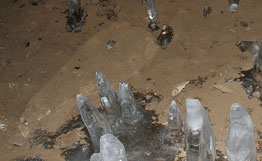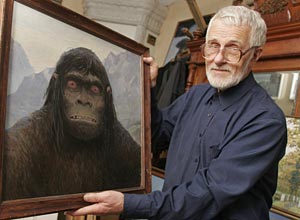
March 25, 2009

The faint outline of a Siberian Yeti track found in a cave can be seen in this Russian photograph.
Breaking Russian media accounts for March 25, 2009, are reporting a delay in the quest for the Siberian Yeti.
The expedition that went looking for unknown Snowmen (called “Bigfoot” in some news items) in a cave in the mountains of Siberia has so far been fruitless, but its organizers blame the weather for failure. They vow to return in summer.
Earlier this week an expedition headed by Yeti specialist (or hominologist) Igor Burtsev set off to explore the several kilometer long cave in the Kemerovo Region, where local hunters reported to have seen the creatures. The expedition returned to Moscow without any success.
“Our expedition visited the Azasskaya Cave. Unfortunately, we did not find any direct evidence of a bigfoot’s presence there,” Burtsev was quoted by RIA Novosti as telling a press conference directly after his return.
But he was not discouraged by this failure, blaming it on bad weather and the curiousity of local people.
“People are simply pouring in there now. If there had been any footprints there originally, they were destroyed,” he said.
Besides, the cave is very deep, Burtsev said, and to explore its full length, a team of speleologists would have to join the mission. Since the exploration was made almost impossible by heavy snow drifts, the expedition should return in summer, he added.
In February 2009, the administration of Kemerovo Region in Russia’s Siberia started receiving reports from local hunters who claimed to have seen human-like creatures near Azasskaya Cave, 500 kilometers off the city of Kemerovo. The creatures reportedly were 4.5-6 feet (1.5-2 meters) tall and covered in hair. One of the hunters also made a photograph of what he said was the creature’s footprint in the snow.
Burtsev, a PhD in History and a passionate researcher of Yetis, says he sees nothing strange about Snowmen/Bigfoot possibly showing up in the Kemerovo region. Its mountains are part of the Altai range, thought to be the favorite Yetis’ reproduction spot. In late 19th and early 20th century, he says, female creatures with young ones were frequently spotted there.
The Russian Academy of Sciences, however, is skeptical of Burtsev’s enthusiasm. To preserve a stable population, there would have to be many Yetis, but only single creatures have so far been spotted, an anthropologist of the Academy, Sergei Vasilyev, told RIA Novosti, according to the MosNews.

The above image appears to match some descriptions of the Russian Bigfoot. For clarification, the website Tochikoni Rossija, a Tajik-Russian Mass Media Project, previously published this photo (above) of the St. Petersburg artist Nikolaj Potapov with his painting of a “relic hominoid.”
Support the cryptozoology museum and use the following button:
Thank you.
About Loren Coleman
Loren Coleman is one of the world’s leading cryptozoologists, some say “the” leading living cryptozoologist. Certainly, he is acknowledged as the current living American researcher and writer who has most popularized cryptozoology in the late 20th and early 21st centuries.
Starting his fieldwork and investigations in 1960, after traveling and trekking extensively in pursuit of cryptozoological mysteries, Coleman began writing to share his experiences in 1969. An honorary member of Ivan T. Sanderson’s Society for the Investigation of the Unexplained in the 1970s, Coleman has been bestowed with similar honorary memberships of the North Idaho College Cryptozoology Club in 1983, and in subsequent years, that of the British Columbia Scientific Cryptozoology Club, CryptoSafari International, and other international organizations. He was also a Life Member and Benefactor of the International Society of Cryptozoology (now-defunct).
Loren Coleman’s daily blog, as a member of the Cryptomundo Team, served as an ongoing avenue of communication for the ever-growing body of cryptozoo news from 2005 through 2013. He returned as an infrequent contributor beginning Halloween week of 2015.
Coleman is the founder in 2003, and current director of the International Cryptozoology Museum in Portland, Maine.
Filed under Abominable Snowman, Almas, Bigfoot, Breaking News, Cryptotourism, CryptoZoo News, Expedition Reports, Yeti